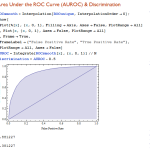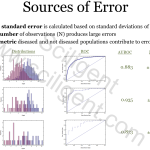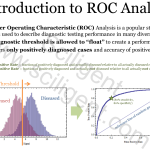Science Daily April 19, 2021 A team of researchers in the US (University of Michigan, The Salk Institute for Biological Studies) has developed online integrative non-negative matrix factorization (iNMF), an algorithm for integrating large, diverse, and continually arriving single-cell datasets. The approach scales to arbitrarily large numbers of cells using fixed memory, iteratively incorporates new datasets as they are generated and allows many users to simultaneously analyze a single copy of a large dataset by streaming it over the internet. Iterative data addition can also be used to map new data to a reference dataset. The improvements in efficiency do […]
Category Archives: Data Analytics
Receiver Operating Characteristics (ROC) Analysis (Part 3 of 3)
This is the third part of a three-segment series on ROC Analysis Code Development This particular client had a significant amount of data and was interested in varying the types of analyses that could be extracted from that data set. As such, we knew that to complete this project efficiently and effectively, it would be our advantage to develop the analysis not as a spreadsheet (which is typical) but as a Mathematica program, which although is more time-consuming on the front end, pays some serious dividends in time-saving as it is repeatedly used. Additionally, especially for this engagement, we knew […]
Receiver Operating Characteristics (ROC) Analysis (Part 2 of 3)
This is the second part of a three-part segment on how we use ROC analysis to help clients benchmark their diagnostic or predictive methods they may be developing. The following are introductory slides we provide as part of every client briefing to explain to them our analytical approach, and to quickly get them up to speed on the essential metrics we will be addressing. In this case, it was necessary for us to provide a simple tutorial on ROC analysis. Slide 1: Slide 2: Slide 3 … and that covers the basic tutorial introduction that we provide for this type […]
Receiver Operating Characteristics (ROC) Analysis (Part 1 of 3)
This is the first part of a three-part series of posts that will walk through a typical data analysis engagement we perform for clients. This part will address aspects of the service and setup. The second part will address the problem faced by the client (in this example, diagnostic pathology). The 3rd part will summarize our conclusion and interpretation and how that data analysis (in this example, ROC analysis) impacts the problem. Motivation Part of the services we offer is advanced data analysis. Many types of statistical data analyses are agnostic to the field of study, and require only […]


